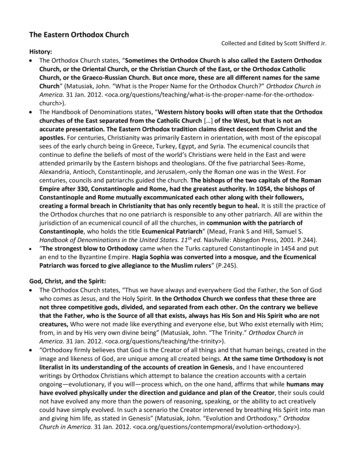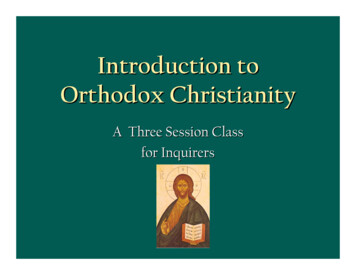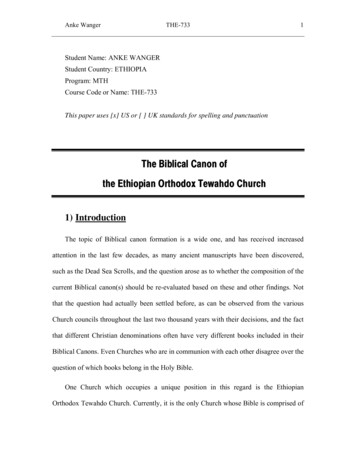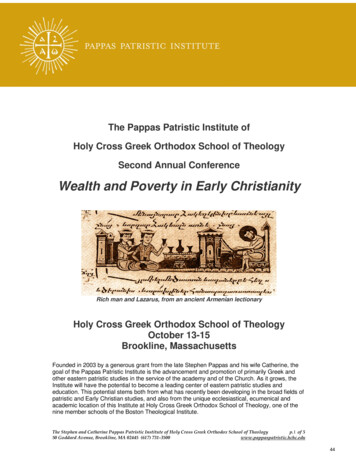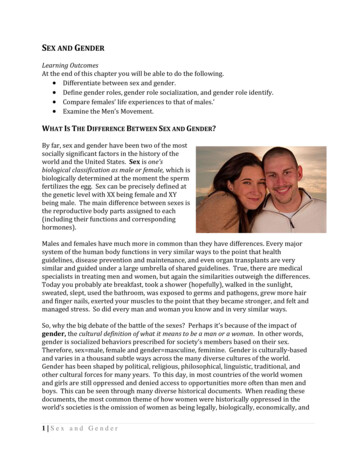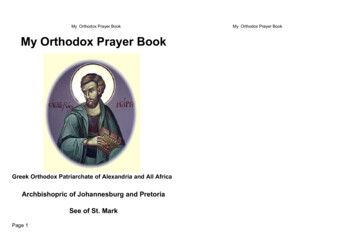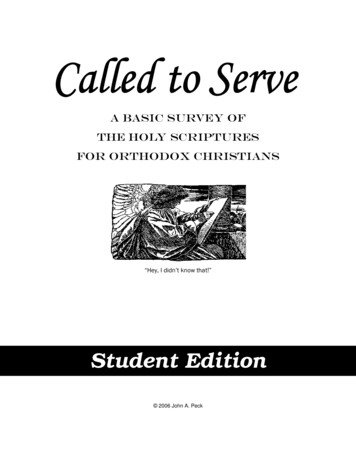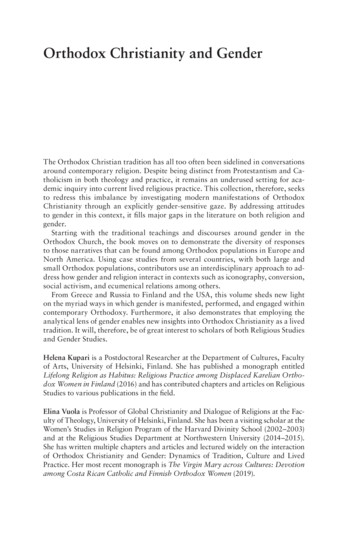
Transcription
Orthodox Christianity and GenderThe Orthodox Christian tradition has all too often been sidelined in conversationsaround contemporary religion. Despite being distinct from Protestantism and Catholicism in both theology and practice, it remains an underused setting for academic inquiry into current lived religious practice. This collection, therefore, seeksto redress this imbalance by investigating modern manifestations of OrthodoxChristianity through an explicitly g ender-sensitive gaze. By addressing attitudesto gender in this context, it fills major gaps in the literature on both religion andgender.Starting with the traditional teachings and discourses around gender in the Orthodox Church, the book moves on to demonstrate the diversity of responsesto those narratives that can be found among Orthodox populations in Europe andNorth America. Using case studies from several countries, with both large andsmall Orthodox populations, contributors use an interdisciplinary approach to address how gender and religion interact in contexts such as iconography, conversion,social activism, and ecumenical relations among others.From Greece and Russia to Finland and the USA, this volume sheds new lighton the myriad ways in which gender is manifested, performed, and engaged withincontemporary Orthodoxy. Furthermore, it also demonstrates that employing theanalytical lens of gender enables new insights into O rthodox Christianity as a livedtradition. It will, therefore, be of great interest to scholars of both Religious Studiesand Gender Studies.Helena Kupari is a Postdoctoral Researcher at the Department of Cultures, Facultyof Arts, University of Helsinki, Finland. She has published a monograph entitledLifelong Religion as Habitus: Religious Practice among Displaced Karelian Orthodox Women in Finland (2016) and has contributed chapters and articles on ReligiousStudies to various publications in the field.Elina Vuola is Professor of Global Christianity and Dialogue of Religions at the Faculty of Theology, University of Helsinki, Finland. She has been a visiting scholar at theWomen’s Studies in Religion Program of the Harvard Divinity School (2002–2003)and at the Religious Studies Department at Northwestern University (2014–2015).She has written multiple chapters and articles and lectured widely on the interactionof Orthodox Christianity and Gender: Dynamics of Tradition, Culture and LivedPractice. Her most recent monograph is The Virgin Mary across Cultures: Devotionamong Costa Rican Catholic and Finnish Orthodox Women (2019).
Routledge Studies in ReligionSaid Nursi and Science in IslamCharacter Building through Nursi’s Mana-i harfiNecati AydinThe Diversity of NonreligionNormativities and Contested RelationsJohannes Quack, Cora Schuh, and Susanne KindThe Role of Religion in Gender-Based Violence, Immigration,and Human RightsEdited by Mary Nyangweso and Jacob K. OluponaItalian American Pentecostalism and the Struggle for Religious IdentityPaul J. PalmaThe Cultural Fusion of Sufi IslamAlternative Paths to Mystical FaithSarwar AlamHindi Christian Literature in Contemporary IndiaRakesh Peter-DassReligion, Modernity, GlobalisationNation-State to MarketFrançois GauthierOrthodox Christianity and GenderDynamics of Tradition, Culture and Lived PracticeEdited by Helena Kupari and Elina VuolaFor more information about this series, please visit: https://www.routledge.com/religion/series/SE0669
Orthodox Christianity andGenderDynamics of Tradition, Culture andLived PracticeEdited byHelena Kupari andElina VuolaLONDON AND NEW YORK
First published 2020by Routledge2 Park Square, Milton Park, Abingdon, Oxon OX14 4RNand by Routledge52 Vanderbilt Avenue, New York, NY 10017Routledge is an imprint of the Taylor & Francis Group, an informabusiness 2020 selection and editorial matter, Helena Kupari andElina Vuola; individual chapters, the contributorsThe right of Helena Kupari and Elina Vuola to be identified asthe authors of the editorial material, and of the authors for theirindividual chapters, has been asserted in accordance with sections77 and 78 of the Copyright, Designs and Patents Act 1988.All rights reserved. No part of this book may be reprinted orreproduced or utilised in any form or by any electronic, mechanical,or other means, now known or hereafter invented, includingphotocopying and recording, or in any information storage orretrieval system, without permission in writing from the publishers.The Open Access version of this book, available atwww.taylorfrancis.com, has been made available under a CreativeCommons Attribution-Non Commercial-No Derivatives 4.0 license.Trademark notice: Product or corporate names may be trademarksor registered trademarks, and are used only for identification andexplanation without intent to infringe.British Library Cataloguing-in-Publication DataA catalogue record for this book is available from the BritishLibraryLibrary of Congress Cataloging-in-Publication DataA catalog record has been requested for this bookISBN: 978-1-138-57420-5 (hbk)ISBN: 978-0-203-70118-8 (ebk)Typeset in Sabonby codeMantra
ContentsList of figuresList of contributors1 Introductionviiix1H E L E N A K U PA R I A N D E L I N A V U O L APART INegotiating tradition2 Gender and Orthodox theology: vistas and vantage points2325BR I A N A. BU TCH ER3 Women in the church: conceptions of Orthodoxtheologians in early twentieth-century Russia47N A D E Z H DA B E L I A KOVA4 Obedient artists and mediators: women icon painters in theFinnish Orthodox Church from the mid-twentieth to thetwenty-first century63K ATA R I I N A H U S S O5 What has not been assumed has not been redeemed: theforgotten Orthodox theological condonement of women’sordination in the 1996 Orthodox and Old Catholicconsultation on gender and the apostolic ministryP E T E R- B E N S M I T80
viContentsPART IILived Orthodoxy6 How to ask embarrassing questions about women’s religion:menstruating Mother of God, ritual impurity, and fieldworkamong Seto women in Estonia and Russia9597A N DR EAS K A LKU N7 Enshrining gender: Orthodox women and material culturein the United States115S A R A H R I C C A R D I - S WA RT Z8 Tradition, gender, and empowerment: the Birth ofTheotokos Society in Helsinki, Finland131P E K K A M E T S O , N I N A M A S K U L I N , A N D T E U VO L A I T I L APART IIICrises and gender9 Shaping public Orthodoxy: women’s peace activism and theOrthodox Churches in the Ukrainian crisis147149H E L E E N Z O RG D R AG E R10 On saints, prophets, philanthropists, and anticlericals:Orthodoxy, gender, and the crisis in Greece171ELEN I SOT IR IOU11 Russian Orthodox icons of Chernobyl as visual narrativesabout women at the center of nuclear disaster190E L E N A RO M A S H KOIndex211
Figures4.14.24.34.411.111.2The artist Martha Neiglick-Platonoff conserving an oldicon of the Mother of God in the 1950sThe language of ancient iconography was studied throughart history. The artist Ina Colliander painting an icon ofthe Mother of God of Kazan in 1968Marianna Flinckenberg-Gluschkoff painting an iconof Christ the Almighty at her home in 1968–1969.Following Ouspensky’s teaching, she mixed the colors inthe palm of her handThe art historian Aune Jääskinen and Hierodeacon Joonain front of the icon “The Mother of God of Konevets.”The icon was covered by an enigmatic riza prior to theresearch that led to its restoration in the 1960sThe icon “The Mother of God of the Victims ofChernobyl” is carried through the demonstrationChernobyl Way in 2017“The Madonna of Chernobyl” by Mikhail Savitsky66676970191197
ContributorsNadezhda Beliakova, PhD, is Senior Research Fellow at the Institute ofWorld History, Russian Academy of Science, and Assistant Professor atSechenov Medical University, Moscow, Russia.Brian A. Butcher, PhD, is Research Fellow in Eastern Christian Studiesin the Metropolitan Andrey Sheptytsky Institute of Eastern ChristianStudies in the University of St. Michael’s College in the University ofToronto, Canada.Katariina Husso, PhD, is Postdoctoral Researcher in the Faculty of Humanities and Social Sciences in the University of Jyväskylä, Finland.Andreas Kalkun, PhD, is Research Fellow at the Estonian Folklore Archives of the Estonian Literary Museum, Tartu, Estonia.Helena Kupari, PhD, is Postdoctoral Researcher at the Department of Cultures of the Faculty of Arts, University of Helsinki, Finland.Teuvo Laitila, PhD, is University Lecturer in Orthodox Church Historyand Comparative Religion at the School of Theology, University of Eastern Finland.Nina Maskulin is a PhD candidate in the Doctoral Program of Theologyand the Study of Religion, University of Helsinki, Finland.Pekka Metso, ThD, is Associate Professor of Practical Theology at theSchool of Theology, University of Eastern Finland.Sarah Riccardi-Swartz is a PhD candidate (ABD) in the Department of A nthropology at New York University, USA.Elena Romashko is a PhD candidate at the department of Religious Studiesat the Georg-August-Universität, Göttingen, Germany.Peter-Ben Smit is Professor of Contextual Biblical Interpretation at VrijeUniversiteit Amsterdam, Netherlands, Professor (ao.) of Systematic andEcumenical Theology at the University of Bern, Switzerland, Professorby special appointment of Ancient Catholic Church Structures and the
xContributorsHistory and Doctrine of the Old Catholic Churches at Utrecht University, Netherlands, and a research associate in the Department of Theology, University of Pretoria, South Africa.Eleni Sotiriou is a sociologist / social anthropologist and an independent researcher, who has previously taught at the University of Erfurt,Germany. Her research interests focus on the relations betweenwomen, socio-cultural change, and religion, particularly within GreekOrthodoxy.Elina Vuola is Professor of Global Christianity and Dialogue of Religions atthe Faculty of Theology, University of Helsinki, Finland.Heleen Zorgdrager is Professor of Systematic Theology and Gender Studiesat the Protestant Theological University in Amsterdam, Netherlands, andvisiting professor to the Ukrainian Catholic University in Lviv, Ukraine.
1Introduction*Helena Kupari and Elina VuolaThe Orthodox Christian tradition appears to many people as patriarchal.These people include both sympathetic and critical outside observers aswell as practicing Orthodox more or less content with and approving of thisaspect of their religion. As with any religious tradition, this interpretationof Orthodoxy can be sustained by historical and theological arguments. Atthe same time, no religious tradition—Orthodoxy included—is merely andmonolithically sexist. Not only are there changes over time, but also multiple views within each tradition. Historical and local circumstances affecthow continuity and change are interpreted and what kinds of modificationscan be made without departing too much from tradition.For example, the Finnish Orthodox Church has recently given up thecustom of bringing infant boys into the altar at 40 days of age as part ofthe service of churching. According to the earlier practice, baby boys werecarried into the altar, whereas baby girls were brought only up to the RoyalDoors leading to the altar. This practice signals the male infant’s potentialclerical vocation (see Butcher in this volume). In their ruling to change thecustom, the Bishops’ Council of the Finnish Orthodox Church argued thatcarrying the baby boy into the altar does not add anything theologicallysignificant to the service (Suomen Ortodoksisen Arkkihiippakunnan Piispainkokous 2002). Moreover, both priests and laypeople had consideredthe custom pastorally problematic. So, nowadays, not even boys are takeninto the altar. According to the Metropolitan emeritus of Helsinki, Ambrosius (personal communication to Elina Vuola), this policy seems to beunique to the Finnish Church: while local practices may vary, no otherOrthodox Church has effected changes to this ancient custom through anofficial decision.The Finnish Orthodox Church can justifiably be considered an exceptional case among Orthodox Churches. It is simultaneously an autonomousnational church and a small minority church embedded in a dominantly* The compiling of this volume and the writing of this chapter have been funded by theAcademy of Finland (project Embodied Religion: Changing Meanings of Body and Gender in Contemporary Forms of Religious Identity in Finland, 2013–2017) and the Finnish Cultural Foundation. The editors thank Nina Maskulin for her help with the index.
2Helena Kupari and Elina VuolaLutheran society. The Orthodox people in Finland face different challengesthan the faithful in the Orthodox heartlands of Eastern and South Eastern Europe or in the diaspora communities of Western Europe and NorthAmerica. Nevertheless, developments within the Finnish Church reflect dynamism that is inherent in Orthodoxy more generally.As two Finnish scholars (of Protestant background) who have studiedFinnish Orthodox women (Kupari 2016; Vuola 2019), we are intrigued bythe myriad ways in which gender is manifested, performed, and engagedwithin contemporary Orthodoxy. This book project has grown out of ourrealization that there is an acute need for comparative gender-sensitive investigations of Orthodox Christianity.Why this book?Gender is a fundamental social categorization influencing all spheres of human life. Religion as a social phenomenon is expressed in relation to thegender constructions of any given society. On the one hand, gendered rolesand norms produce gendered patterns of religious behavior and belief, and onthe other, religious teachings and traditions are used to legitimize, and sometimes to undercut, established power relations between men and women.Orthodox Christianity takes different forms in various social and cultural contexts. This book describes and analyzes lived expressions of andnegotiations with the Orthodox tradition in several such contexts in E uropeand the United States in the twentieth and twenty-first centuries. It coversa wide array of gender-related phenomena and issues: theological, social,political, ethical, and practical. Our aim is to demonstrate both similaritiesacross and differences between local manifestations of Orthodoxy, to capture crosscutting themes as well as individual cases.The scholars contributing to this volume are based in several disciplines:theology, religious studies, history, art history, folklore studies, anthropology, and sociology. In their chapters, they apply methods and theoriescommon to their respective disciplines. Many also take an interdisciplinaryapproach such as combining theological reflection with sociological analysis. They investigate a rich variety of primary sources, including theological writing, folklore, memoirs, letters, speeches, and social media content.Some chapters are based on interviews and participant observation. Whatunites them is that their analyses deploy an explicitly gender-sensitive gaze.The Orthodox Christian tradition has been much less studied from theperspective of gender than other branches of Christianity—as well as manyother religious traditions. This major lacuna in scholarship, especially inAnglophone research, is the result of several intertwining factors. First, themeagerness of gender-sensitive research on Orthodoxy reflects the “doubleblindness” that has, for a long time, hampered the full integration of questions related to gender and religion into research agendas. That is to say,whereas gender studies have suffered from a blindness to religion, religious
Introduction 3studies and theology have suffered from a blindness to gender. This situation is changing, but it is still far from standard that scholars of religionacknowledge the importance of gender in their work or that scholars ofgender pay due attention to religion in theirs (Vuola 2016a).Second, Orthodox Christianity as such is an understudied field in theology, religious studies, and the social sciences—beyond specifically Orthodoxinstitutions. While the Iron Curtain was up, the scientific study of religionwas severely restricted in the academic establishments of the Eastern Bloc,which set back research on this topic in many Orthodox-dominated countries (Bubík and Hoffman 2015). In Western Europe and North America,the bulk of scholarship—particularly empirical scholarship—on Christianityhas always focused on the Western churches. This applies also to researchthat combines an interest in religion with gender-related concerns. Generally speaking, gender studies is established as a discipline in the universitiesof Western Europe and North America, regions where Orthodoxy does notconstitute a particularly prominent research area.Gender-sensitive research on Orthodox Christianity is relatively scarce,both in theological elaborations and empirically based studies. Comparedto other branches of Christianity, very little feminist theology has been produced from within the Orthodox tradition. Some Orthodox women writeexplicitly from a female perspective, however, without necessarily callingtheir work feminist (see, e.g., Behr-Sigel 1991; Behr-Sigel and Ware 2000;Karras 2002, 2006).The obvious need for further theological analysis notwithstanding, wemaintain that at present it is principally through empirical—historical, sociological, and ethnographic—research that essential knowledge is gainedabout gender-related issues and women’s realities in Orthodoxy. In religious traditions such as Orthodox Christianity, in which women hold lessformal power and right to interpretation than men, it is particularly important to understand how women produce and reproduce theological ideas aswell as embody and challenge them in their lives. Furthermore, on accountof the Orthodox rhetoric of unity and stability, it is also crucial to shedlight on little-known policies and instances through which gender-related practices—such as churching in Finnish Orthodoxy—have been established, perpetuated, or transformed in different national churches and onthe local level. Therefore, while this book includes theologically orientedchapters, its emphasis is on empirical research. Only through a variety ofconcrete case studies can this inner diversity of Orthodoxy be illuminated.Gender is still very much an emerging field in Orthodox scholarship.The central objective of this book is to put together interesting examples oftopical research scattered across disciplines to produce a partial overviewof the state of the art. We believe that, taken together, the individual chapters make a fascinating and unique whole and testify to the relevance ofgender-sensitive scholarship on Orthodoxy. Our hope is that the book willpave the way for more focused discussions in the future.
4Helena Kupari and Elina VuolaUnity and diversity in Orthodox ChristianityOrthodox Christendom consists of a communion of independent churches.The case studies presented in this volume all discuss the Chalcedonian orEastern Orthodox Churches that include the four ancient patriarchates(Constantinople, Alexandria, Antioch, and Jerusalem) as well as a numberof churches that trace their origins to the Byzantine Empire and its missionary activities. Altogether, the family of Chalcedonian Churches presentlyincludes around 15 fully independent or autocephalous churches as well asa few autonomous churches all linked to a certain autocephalous church. Byfar the largest in terms of membership is the Russian Orthodox Church. Thestatus of some local churches remains contested; in this respect, disputeshave most recently flared up in Ukraine (see Zorgdrager in this volume).There are no jurisdictional structures binding the autocephalous localchurches together. Each church has its own hierarchy and administration,yet shares in the understanding of the fundamental unity of all the individual churches as the Orthodox Church (Grdzelidze 2011). Simultaneously,the practices and policies of each church are firmly embedded in a specificsocial and cultural context and reflect a specific historical trajectory. Toconceptualize the dynamic between the universal claims and local manifestations of Orthodoxy, Sonja Luehrmann (2018, 12–13) has recentlysuggested that Orthodox Christianity can be approached as a “discursivetradition,” similarly to how Talal Asad (2009) has conceived of Islam.Orthodoxy, like Islam but unlike Catholicism, lacks a central interpretative authority. The Orthodox Church emphasizes fidelity to apostolic tradition as realized, first and foremost, in the Scriptures, canons (consisting,most importantly, of the decisions of the Ecumenical Councils), writingsof the Church Fathers, and in the liturgical life of the church. However,no single person or office has the final say on how these various sourcesshould be related to each other and applied in a specific situation. This,states Luehrmann (2018, 15–16) leaves “room for choice, enabled, but alsoconstrained, by the fiction of the overall spiritual unity of the church.”In a similar vein, Maria Hämmerli and Jean-François Meyer (2014, 22)conclude that in the Orthodox Church, innovation involves the creativeinterpretation of tradition, while adaptations and reforms are “justified inthe name of deepening the meaning of tradition and not as departing fromthe past” (see also Butcher in this volume).These interpretations can also be used to make sense of how gender isnegotiated in Orthodox Christianity. The process is characterized by a dynamic tension between the appeal to immutable teachings and authoritativerepresentations and the commitment to “allow for a ‘normal’ functioning”(Hämmerli and Meyer 2014, 21), in particular historical moments, localrealities, and personal circumstances. This dynamic tension ensures that,for both institutions and individuals, discerning and living true to the essence of gender as understood in Orthodox anthropology consists of more
Introduction 5than rote reiteration of old forms. Depending on contextual factors, projects engaging with gender in the spirit of tradition can result in either increased flexibility or rigidity of gendered roles, norms, and representations(see B eliakova, Smit, and Sotiriou in this volume).Gender in Orthodox Christianity: preliminary remarksGender has been embedded in Christian theology since its inception. Womenand feminine symbolism have always featured in Christian theology, whichwas formulated and canonized by men from the earliest centuries, as evidenced in the authorship of the New Testament texts and patristic theology.All Christian churches have a complex history of excluding and nurturingnegative interpretations of women and, relatedly, of the body and sexuality.Theological anthropology—the theologically based image of the humanbeing in relation to God, creation, and other people—is central to all critical assessments of Christian views of gender, bodiliness, sexuality, andespecially women. Orthodox and Catholic understandings of gender arebased on the idea of God-given complementarity between women and men.In Orthodox theology, the God-given roles, qualities, and functions of human beings tend to be interpreted as immutable and essentialist. In reality, conceptions of complementarity are not disjointed from the surrounding culture and society or from historical changes.The theological basis of gender has direct relevance to how OrthodoxChurches discuss—or are silent about—women’s participation in churchlife, the relationship between men and women, and sexual ethics (seeButcher, Metso et al., and Smit in this volume). An important way in whichcomplementarity is applied in practice is priesthood. The prohibition ofwomen’s ordination is based on an understanding of the priest as an imageof Christ. The priest stands in the place of Christ who was male (Demacopoulos 2011, 456). This view, shared by the entire Orthodox world,comes close to the Catholic understanding of priesthood where Christ’smaleness is considered so essential that it overrules any other human qualities. In Protestant Churches, the understandings of priesthood do not hingeon a complementary and essentialist notion of gender difference, often allowing for a more flexible stand on women’s ordination. Ordination is nota sacrament and pastors are not considered to represent Christ.Complementarity also bears upon the practices and policies of Orthodox Churches in the delineation of social and sexual ethics. Unlikepriesthood, this has direct relevance to the lives of millions of people. Forinstance, referring to the 2005 document “The Basis of the Social Concept of the Russian Orthodox Church” produced by the Moscow Patriarchate, Elena Chernyak (2016) notes that while the equality of men andwomen before God is a ffirmed by the church, this equality does not eliminate their “natural” differences or translate into gender equality in familiesand society. According to the church, women have a God-given destiny in
6Helena Kupari and Elina Vuolamarriage and motherhood and their role in the family is subordinate to thehusband as the head of the household (Chernyak 2016, 303–305).Orthodox anthropology conceives of the human being as imago dei, capable of deification (theosis). This image is, in certain aspects, morepositive than the Protestant view, which tends to emphasize the fallennessand sinfulness of humanity. More broadly speaking, Orthodox theologyemphasizes the sacramentality or sacredness of all reality, including thenatural and material world, as the primary sign of God’s mercy and love (McGuckin 2008, 475). Both notions have implications for the understanding of bodiliness and sexuality, and could potentially underpin a new theology of gender. In practice, however, women’s “negative” characteristicsare often presented as obstacles to their greater participation in church life.At the same time, the prominent status accorded to female saints and,above all, to the Mother of God gives the Orthodox Church a “feminine”character—especially when compared to Protestant Churches, many ofwhich ordain women but pay considerably less attention to the Virgin Maryin their theology, liturgy, and spirituality. The Mother of God is an idealfor both Orthodox women and men to follow. Furthermore, she is the AllHoly (Panagia), higher than the angels, the most powerful intercessor andsymbol of protection (McGuckin 2008, 501–509).Over the course of the past 60 years, debates concerning gender andsexuality have taken center stage in Protestant and Catholic ecclesiasticalpolicy and academic theology. Although these issues have been discussedfar less in the Orthodox tradition, this does not mean that there is no recognition of their relevance. Niki J. Tsironis (2011), for example, argues thatthe Orthodox Church needs to reconsider the place of women in ecclesialstructures and offices, because in today’s world it is impossible to discuss“women” without taking into account the vast social changes in their role.In her view, while some initiatives aiming at such reconsideration have already been launched, a long road still lies ahead (Tsironis 2011, 641).Orthodoxy and gender in modern timesThe contributions to this volume are all set within the broad context of modernity. The oldest materials discussed in the book (excluding theological writings) date from the turn of the twentieth century, while approximately half of the case studies concern the present day. Modern structuresof governance, technologies, and imaginaries do not produce identical results everywhere. Rather, processes of modernization play out differently in d ifferent societies. Nevertheless, dictating the defining attributesof modernity has historically been a Western European prerogative. The“Western” narrative of modernity has conceived of modernization as a process spreading from Western Europe and promoting values and policiesprevalent in this part of the world. The hegemonic status of this narrativehas only recently been seriously challenged, for example, through advancesmade in postcolonial and postmodern theory (Makrides 2012, 249–251).
Introduction 7Processes of modernization have multifarious influences on differentlypositioned people such as men and women. The gendered effects of modernization include the so-called feminization of religion or the greater religious involvement of women than men in present-day European and NorthAmerican societies (Keinänen 2016). Scholars have suggested that, in thesesocieties, modernization had more of a secularizing influence on men thanon women. In fact, as laymen disaffiliated from churches, laywomen often took on additional religious responsibilities (Woodhead 2007; Aune,Sharma, and Vincett 2008). While discussions concerning the feminizationof religion mostly concern countries where the Western churches dominate,parallel gender disparities in religious activity have also been documentedin Orthodox-dominated societies (e.g., Dubisch 1995; see also Beliakova,Kalkun, and Sotiriou in this volume).The relationship between Orthodox Christianity and modernity isstrained (e.g., Roudometof, Agadjanian, and Pankhurst 2005; Willert andMolotokos-Liederman 2012). In his insightful analysis of this relationship,Vasilios Makrides (2012, 257–261) notes that arguments for the incompatibility of Orthodox Christianity with modernity have been posed byboth Western Christian and Communist critics—as well as by advocatesof Orthodoxy. Due to a number of historical factors, Orthodox Churchestend to distrust or downright reject various advances connected with theWestern narrative of modernity. These include religious pluralism, culturalliberalism, individualism, and a secular or religiously neutral state. Orthodox Churches severely criticize:the modern western system of values and alternative lifestyles and theirrepercussions in many domains, because they are considered as l eadingto the demise of traditional values and inst
Orthodox Church, the book moves on to demonstrate the diversity of responses to those narratives that can be found among Orthodox populations in Europe and North America. Using case studies from several countries, with both large and small Orthodox population
